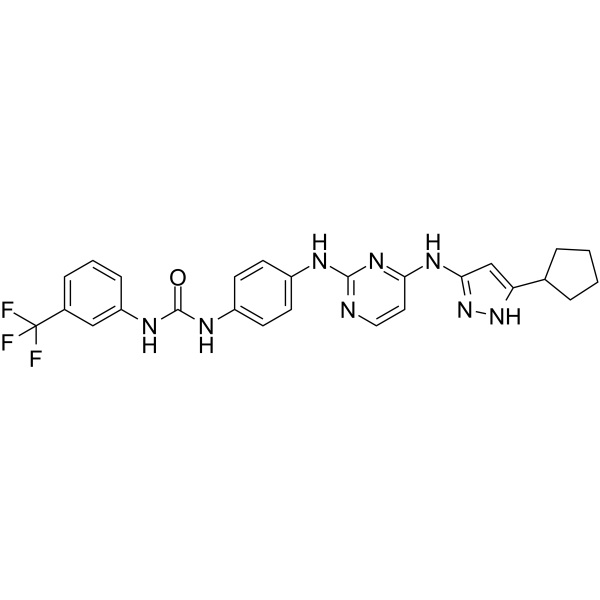1639009-81-6
| Name | CD532 |
|---|
| Description | CD532 is a potent Aurora A kinase inhibitor with an IC50 of 45 nM. CD532 has the dual effect of blocking Aurora A kinase activity and driving degradation of MYCN. CD532 also can directly interact with AURKA and induces a global conformational shift. CD532 can be used for the research of cancer[1][2]. |
|---|---|
| Related Catalog | |
| Target |
Aurora A:45 nM (IC50) |
| In Vitro | CD532 (1-10000 nM; 72 h) is cytotoxic in MYCN-amplified neuroblastoma cell lines SK-N-BE(2) and Kelly, with EC50s of 223.2 nM and 146.7 nM, respectively[1]. CD532 (0.1-1 μM; 24 h) causes dose-dependent loss of MYCN protein in SK-N-BE(2) cells[1]. CD532 (1 μM; 6 h) prevents S-phase entry in SK-N-BE(2) cells[1]. Cell Viability Assay[1] Cell Line: SK-N-BE(2) and Kelly cells Concentration: 1, 10, 100, 1000, 10000 nM Incubation Time: 72 hours Result: Inhibited the cell viability of SK-N-BE(2) and Kelly cells, with EC50s of 223.2 nM and 146.7 nM, respectively. Cell Cycle Analysis[1] Cell Line: SK-N-BE(2) cells Concentration: 1 μM Incubation Time: 4 hours Result: Resulted in a rapid and potent loss of S-phase and accumulation in both G0/G1 and G2. Western Blot Analysis[1] Cell Line: SK-N-BE(2) cells Concentration: 0.1, 0.25, 0.5, 1 μM Incubation Time: 2, 4, 6, 24 hours Result: Causes dose-dependent and time-dependent loss of MYCN protein. |
| In Vivo | CD532 (25 mg/kg; i.p. twice weekly for 3 weeks) decreases the tumor volume and increases survival in mice with subcutaneous sonic hedgehog (SHH)-subtype medulloblastoma[1]. CD532 (60 mg/kg; i.p. for 2 days) decreases the level of MYCN protein in MYCN-amplified neuroblastoma xenografts[1]. CD532 (20 mg/kg; i.p.) shows a serum half-life of ~1.5 hours and AUC0-24 of 27 μM•h in mice[1]. Animal Model: Homozygous nu/nu mice with SHH-subtype MYCN-expressing medulloblastoma[1] Dosage: 25 mg/kg Administration: I.p. twice weekly for 3 weeks Result: Decreased the level of MYCN protein and tumor volume and increases survival. |
| References |
| Molecular Formula | C26H25F3N8O |
|---|---|
| Molecular Weight | 522.52 |
